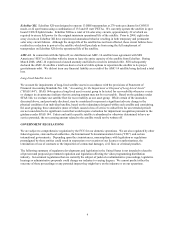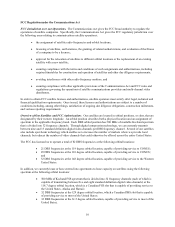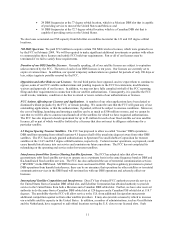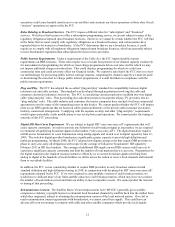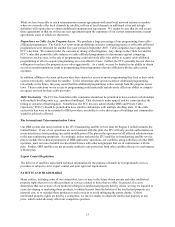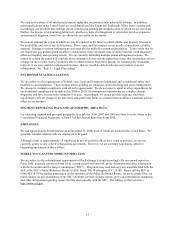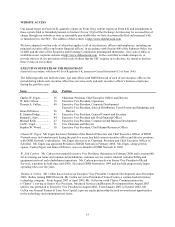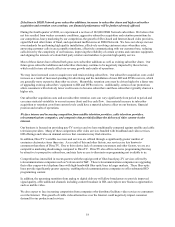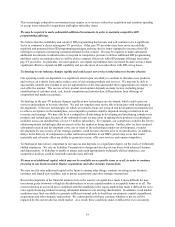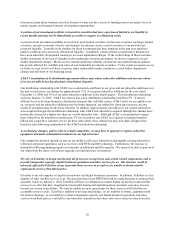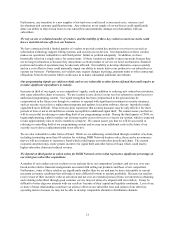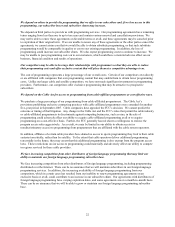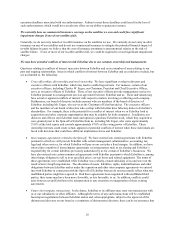Dish Network 2008 Annual Report Download - page 29
Download and view the complete annual report
Please find page 29 of the 2008 Dish Network annual report below. You can navigate through the pages in the report by either clicking on the pages listed below, or by using the keyword search tool below to find specific information within the annual report.
19
This increasingly competitive environment may require us to increase subscriber acquisition and retention spending
or accept lower subscriber acquisitions and higher subscriber churn.
We may be required to make substantial additional investments in order to maintain competitive HD
programming offerings.
We believe that the availability and extent of HD programming has become and will continue to be a significant
factor in consumer’s choice among pay-TV providers. Other pay-TV providers may have more successfully
marketed and promoted their HD programming packages and may also be better equipped to increase their HD
offerings to respond to increasing consumer demand for this content. We may be required to make substantial
additional investments in infrastructure to respond to competitive pressure to deliver additional HD programming,
and there can be no assurance that we will be able to compete effectively with HD program offerings from other
pay-TV providers. In particular, in recent quarters, our capital expenditures have increased because we have made
significant efforts to expand our HD capability and provide more of our subscribers with HD set top boxes.
Technology in our industry changes rapidly and could cause our services and products to become obsolete.
Our operating results are dependent to a significant extent upon our ability to continue to introduce new products
and services on a timely basis and to reduce costs of our existing products and services. We may not be able to
successfully identify new product or service opportunities or develop and market these opportunities in a timely or
cost-effective manner. The success of new product development depends on many factors, including proper
identification of customer need, cost, timely completion and introduction, differentiation from offerings of
competitors and market acceptance.
Technology in the pay-TV industry changes rapidly as new technologies are developed, which could cause our
services and products to become obsolete. We and our suppliers may not be able to keep pace with technological
developments. If the new technologies on which we intend to focus our research and development investments fail
to achieve acceptance in the marketplace, our competitive position could be impaired causing a reduction in our
revenues and earnings. We may also be at a competitive disadvantage in developing and introducing complex new
products and technologies because of the substantial costs we may incur in making these products or technologies
available across our installed base of over 13 million subscribers. For example, our competitors could be the first to
obtain proprietary technologies that are perceived by the market as being superior. Further, after we have incurred
substantial research and development costs, one or more of the technologies under our development, or under
development by one or more of our strategic partners, could become obsolete prior to its introduction. In addition,
delays in the delivery of components or other unforeseen problems in our DBS system may occur that could
materially and adversely affect our ability to generate revenue, offer new services and remain competitive.
Technological innovation is important to our success and depends, to a significant degree, on the work of technically
skilled employees. We rely on EchoStar Corporation to design and develop set-top boxes with advanced features
and functionality. If EchoStar is unable to attract and retain appropriately technically skilled employees, our
competitive position could be materially and adversely affected.
We may need additional capital, which may not be available on acceptable terms or at all, in order to continue
investing in our business and to finance acquisitions and other strategic transactions.
We may need to raise additional capital in the future to among other things, continue investing in our business,
construct and launch new satellites, and to pursue acquisitions and other strategic transactions.
Recent developments in the financial markets such as the scarcity of capital have made it more difficult for non-
investment grade borrowers of high yield indebtedness to access capital markets at acceptable terms or at all. The
recent reduction in our stock price combined with the instability in the equity markets has made it difficult for us to
raise equity financing without incurring substantial dilution to our existing shareholders. In addition, weak market
conditions may limit our ability to generate sufficient internal cash to fund these investments, capital expenditures,
acquisitions and other strategic transactions. We cannot predict with any certainty whether or not we will be
impacted by the current adverse credit market. As a result, these conditions make it difficult for us to accurately


